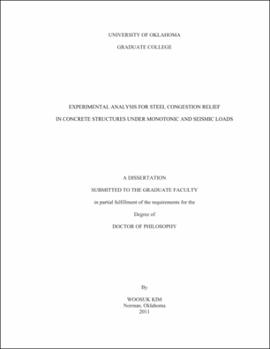| dc.contributor.advisor | Kang, Thomas | |
| dc.creator | Kim, Woosuk | |
| dc.date.accessioned | 2019-04-27T21:25:47Z | |
| dc.date.available | 2019-04-27T21:25:47Z | |
| dc.date.issued | 2011 | |
| dc.identifier | 99185943102042 | |
| dc.identifier.uri | https://hdl.handle.net/11244/318656 | |
| dc.description.abstract | Since the beginning of this PhD research, the author has endeavored to determine how to resolve the issues involving steel congestion in reinforced concrete (RC) structures. Three potential solutions to this problem were researched in detail. In the first method, reinforced concrete (RC) was mixed with steel fibers. The use of steel fibers instead of shear reinforcement stirrups resulted in the reduction of steel congestion in a manner which was both effective in reducing the effects of congestion and which was practical to implement. In the second method, steel congestion in reinforced concrete (RC) was effectively reduced by the use of self-consolidating concrete (SCC), which does not require the use of vibrators in its casting. In the final method, steel congestion was effectively reduced by the use of headed bars instead of traditional hooked bars. This first and third approach is emerging as a research topic of special interest in the American Concrete Institute (ACI). | |
| dc.description.abstract | In evaluating these three approaches, and in combining them in this study, varied types of concrete were used. Shear testing was conducted using a lightweight concrete mix. Flexural testing of lightweight prestressed concrete (PC) beams was conducted using self-consolidating concrete (SCC). Seismic testing of headed bars in RC beam-column connections was conducted using a normalweight concrete mix. These three experiments were the subject matter of this study. In these studies the experimental results were compared with the ACI 318-08 provisions and with existing modeling equations proposed by many researchers. New models were proposed which better correlated with the test results were proposed. | |
| dc.description.abstract | Therefore, although other studies in the world may have dealt with the relief of steel congestion in RC and/or PC structures, in researching these three unique methods for the relief of steel congestion it was discovered that several variations and combinations of such methods can provide effective solutions for diverse conditions. Most of all, this study should prove important in providing the basis for additional research since the guidelines and codes regarding the relief of steel congestion are shown to be based upon previously limited data. | |
| dc.format.extent | 169 pages | |
| dc.format.medium | application.pdf | |
| dc.language | en_US | |
| dc.relation.requires | Adobe Acrobat Reader | |
| dc.subject | Reinforced concrete construction | |
| dc.subject | Self-consolidating concrete | |
| dc.subject | Prestressed concrete construction | |
| dc.subject | Steel, Structural | |
| dc.title | EXPERIMENTAL ANALYSIS FOR STEEL CONGESTION RELIEF IN CONCRETE STRUCTURES UNDER MONOTONIC AND SEISMIC LOADS | |
| dc.type | text | |
| dc.type | document | |
| dc.thesis.degree | Ph.D. | |
| ou.group | College of Engineering::School of Civil Engineering and Environmental Science | |
